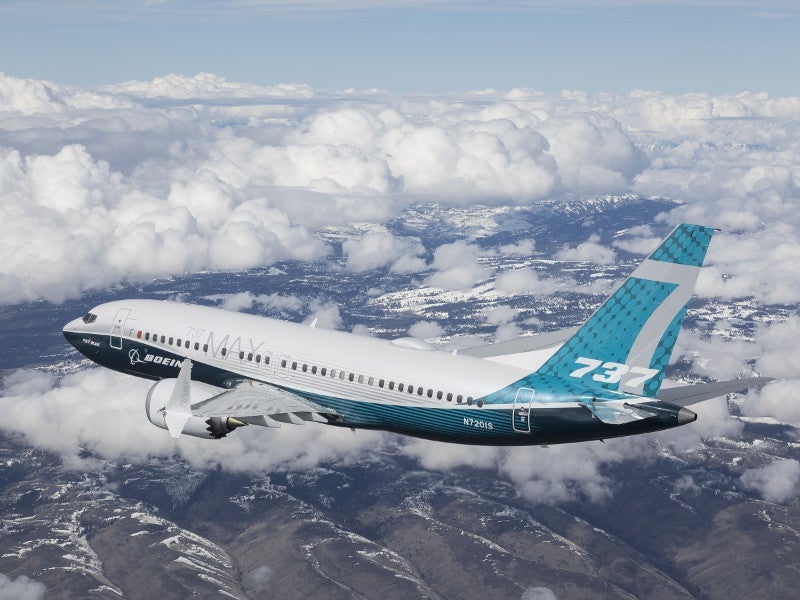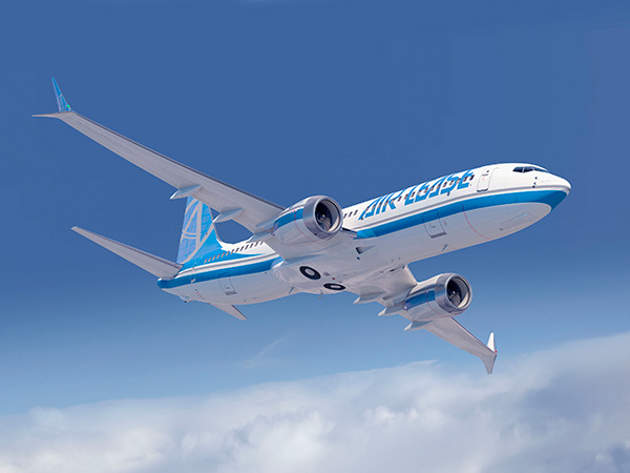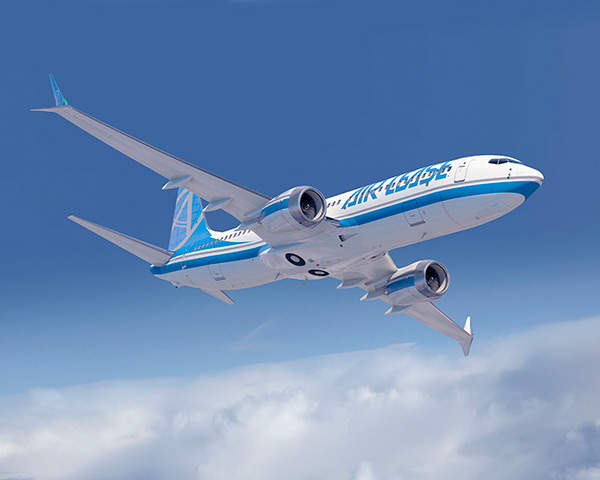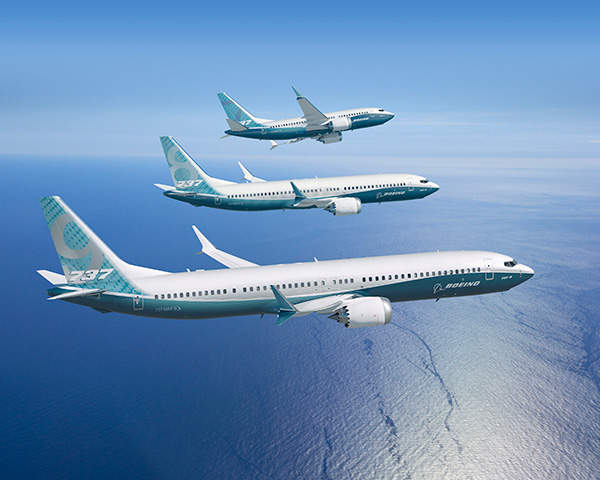Boeing 737 MAX, a new family of twin-engine airliners developed by Boeing, is based on the world’s best-selling aircraft Next-Generation 737.
The 737 MAX aircraft family includes the 737 MAX 7, 737 MAX 8, 737 MAX 9, 737 MAX 10 and 737 MAX 200 variants. The new range of aircraft is intended to deliver improved fuel efficiency for the customers in the single-aisle segment.
The 737 MAX development programme was approved by the company’s board of directors in August 2011. The first 737 MAX 7 was launched in May 2013. The first 737 Max entered service in May 2017, while Boeing rolled out the first 737 MAX 8 in December 2015.
The aircraft made its first flight in January 2016 and was first delivered to Malindo Air in May 2017.
The newest member 737 MAX 10 was launched at the 2017 Paris Air Show.
Several aviation regulators around the world, including the US Federal Aviation Administration (FAA), ordered the grounding of the Boeing 737 MAX in 2019 in the wake of the crash of two new aircraft, a Lion Air Flight 610 and Ethiopian Airlines Flight 302, within five months. Authorities of Indonesia, Ethiopia and the US conducted investigations and published their findings. Boeing, which halted the production of the aircraft after the series of groundings, expects the aircraft to return to service in mid-2020.
Boeing 737 MAX design
The super-efficient design of 737 MAX incorporates new winglet technology, delivering a fuel-burn advantage. The fuselage is strengthened to accommodate new engines.
The expanded tail cone and the thickened segment over the flight control surfaces improve steadiness of airflow and avoid the vortex generators on the tail.
The modifications further reduce the drag and improve the fuel-efficiency of the airliners. The aircraft delivers an 8% a seat advantage compared to other aircraft in the single-aisle segment.
Flight deck and cabin of the twin-engine airliners
The flight deck can house the pilot and a co-pilot and is equipped with a common display system (CDS) supplied by Honeywell Air Transport Systems. The CDS consists of six flat-panel liquid crystal displays (LCDs).
The flight controls include fly-by-wire spoilers instead of a mechanical system to achieve weight reductions. The aircraft is equipped with anti-icing systems and an electronic bleed air system to improve cabin pressurisation.
The cabin of the 737 MAX features the passenger-preferred Boeing Sky Interior. The interior boasts modern-sculpted side-walls, a spacious cabin with more headroom, swivelling overhead stowage bins and an LED lighting system. The larger bins provide more space to passengers for storing carry-on roll-aboard luggage near their own seat.
Reading-light switches are redesigned to avoid the accidental pressing of the flight-attendant call button. Other eminent features include new speakers and tamper-proof air grill.
737 MAX engine details
The 737 MAX is powered by CFM International LEAP-1B engines, which are integrated with the wing similar to those of 787 Dreamliner engine. The 737 MAX engine reduces CO₂ emissions by an additional ten to 12% in comparison with existing fuel-efficient single-aisle aircraft.
CFM International received type certificates from the European Aviation Safety Agency (EASA) and the US Federal Aviation Administration (FAA) for its LEAP-1B engine in May 2016.
Boeing 737 MAX landing gear
The 737 MAX is equipped with the retractable tricycle-type landing gear. The main landing gear is strengthened to accommodate the increase in loads due to the larger engines.
The nose gear door design is modified to complement a larger engine fan. The nose landing gear is lengthened to 20cm to achieve the required ground clearance while housing the larger engine fan.
International orders for Boeing’s new aircraft
Boeing has so far received approximately 4,800 orders for 737 MAX aeroplanes from more than 100 customers across the world.
In December 2011, Boeing received the first firm order for 150 737 MAX aircraft from launch customer Southwest Airlines.
In January 2012, Norwegian Air Shuttle placed an $11.4bn firm order for 100 737 MAX aircraft and 22 Next-Generation 737-800s. Lion Air finalised a $22.4bn firm order for 201 737 MAXs and 29 Next-Generation 737-900ERs in February 2012. Virgin Australia finalised a firm order with Boeing in July 2012 for 23 737 MAX aircraft, in addition to four options.
In July 2012, Boeing received a $7.2bn firm order from Air Lease Corporation to deliver 60 737 MAX 8 and 15 737 MAX 9 aircraft. The contract also includes reconfirmation rights for 25 more 737 MAX aircraft. United Air Lines placed a $14.7bn firm order for 100 737 MAXs and 50 Next-Generation 737s in July 2012.
GE Capital Aviation committed to buying 75 737 MAX 8s and 25 Next-Generation 737-800s at the Farnborough International Airshow in 2012. Aircraft leasing companies ALAFCO and Avolon also announced their commitments at the airshow to purchasing Boeing 737 MAX 8 and MAX 9 aircraft. Icelandair and SilkAir respectively placed orders with Boeing for the delivery of 12 and 31 737 MAXs in 2012.
In 2013, Boeing received orders for 737 MAX from WestJet (65 aircraft), Travel Service (3), CIT Group (30), Turkish Airlines (50) and Icelandair (16). Boeing received orders from SunExpress (15), Nok Airlines (7), SpiceJet (42), Comair (8), China Eastern, Turkish Airlines (15), Okay Airway (6), Air Lease (20), Avolon (5), Ethiopian Airlines (20), Monarch Airlines (30), SMBC Aviation (80) and Jetlines (5) for the delivery of 737 MAX 8s in 2014.
Boeing received an order from Air Canada for delivery of 61 737 MAX aeroplanes, including 33 737 MAX 8s and 28 737 MAX 9s. The contract also includes an option to buy 18 aircraft and rights to purchase 30 additional 737 MAXs.
SMBC Aviation placed an additional order with Boeing during 2014 Paris Air Show for the delivery of 10 737 MAX 8s.
In October 2014, Boeing received an order from Garuda Indonesia for 50 737 MAX aircraft.
AerCap placed an order for 100 737 MAX 8s at the Paris Air Show held in June 2015.
Enter Air placed an order with Boeing for two 737 MAX 8s and two Next-Generation 737-800s in June 2015.
Jet Airways placed an order for 75 Boeing 737 MAX 8 aircraft in November 2015.
Korean Air signed a contract with Boeing for 30 737 MAXs and two additional 777-300ER (Extended Range) jetliners in November 2015.
Boeing received an order from BOC Aviation for the delivery of 11 Next-Generation 737-800s and 11 737 MAX 8 aircraft in November 2015.
In May 2016, Boeing received an $11.3bn order from VietJet to deliver 100 737 MAX 200 aeroplanes. Deliveries are scheduled will continue through 2023.
Boeing received an order from a Chinese customer for 30 737 aircraft, including 737 MAX and Next-Generation 737 airliners at Farnborough Airshow held in July 2016.
Air Europa placed an order with Boeing for 20 737 MAX 8s during the Farnborough International Airshow 2016.
Malaysia Airlines placed an order for more than 50 737 MAX aircraft, including 25 737 MAX 8s. The order also includes rights to purchase additional 737 MAX 8 and 737 MAX 9 airliners.
Malaysia Airlines awarded a $1.25bn contract to Boeing to convert ten of its 737 MAX 8 aircraft to 737 MAX 10s at the Paris Air Show in June 2017.
Boeing signed a memorandum of understanding with Ruili Airlines for 20 737 MAXs valued $2.2bn and with Xiamen Airlines for ten 737 MAX 10 aircraft worth $1.2bn.
AerCap signed a deal for the conversion of 15 737 MAXs to 737 MAX 10 standard, while Algerian carrier Tassili Airlines ordered three next-generation 737-800 aircraft valued $294m at the same airshow. A major airline, whose name was not disclosed, signed a $14bn deal for 125 737 MAX 8 aircraft.
Other orders placed at the airshow include those by Copa Airlines (15 737 MAX 10), China Aircraft Leasing Group (50 737 MAX), Mauritania Airlines (one 737 MAX 8), Ryanair (ten 737 MAX), Blue Air (six 737 MAX), Aviation Capital Group (20 737 MAX 10), Okay Airways (15 737 MAX), and Donghai Airlines for the conversion of ten 737 MAX aircraft on order to 737 MAX 10s.
Japan Investment Adviser, Air Lease Corporation and BOC Aviation finalised orders for ten 737 MAX 8, 12 737 MAX and ten 737 MAX ten aircraft respectively in August 2017.
In November 2017, aircraft leasing company Avolon placed an $11bn order for the purchase of 55 MAX 8 and 20 MAX 10 aircraft with options for 20 additional MAX 8 aircraft.
A $674m order was placed by Kazakhstan-based airline SCAT Airlines for six 737 MAX 8 at the Dubai Airshow held in November 2017. flydubai signed an agreement with Boeing at the airshow to buy up to 175 MAX aircraft with purchase rights for another 50 MAXs valued at $27bn. A $2.2bn order was finalised by Kuwait-based aircraft-leasing company ALAFCO for 20 737 MAX 8 aircraft.
CDB Aviation finalised a $7.4bn deal for 42 737 MAX 8s, ten 737 MAX 10s and eight 787-9 Dreamliners in November 2017.
The first Boeing 737 MAX 8 aircraft was handed over to Dubai Aerospace Enterprise (DAE) in July 2018. VietJet ordered 80 737 MAX 10s and 20 737 MAX 8s for $12.7bn in the same month.
In November 2018, Fiji Airways took the delivery of its first 737 MAX plane and Cayman Airways received the first 737 MAX through leasing company Air Lease Corporation. Jeju Air ordered 40 737 MAX 8s with an option for ten additional aircraft for $5.9bn in the same month.
In December 2018, Boeing delivered the first 737 MAX 8 aircraft to Korean airline Eastar Jet and the first 737 MAX aircraft to Royal Air Maroc. In the same month, Boeing signed an agreement with Middle East carrier flyadeal airline to sell up to 30 737 MAX aircraft for $5.9bn. The order includes options to order 20 additional aircraft.
International Airlines Group (IAG) signed a letter of intent with Boeing to purchase 200 737 Max jets in June 2019.
In July 2019, Saudi Arabian airline Flyadeal cancelled its deal with Boeing to buy 30 aircraft because of the fatal crashes in Indonesia and Ethiopia.








